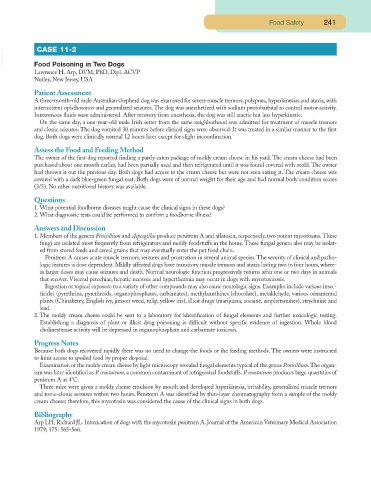Page 238 - Small Animal Clinical Nutrition 5th Edition
P. 238
Food Safety 241
CASE 11-2
VetBooks.ir Food Poisoning in Two Dogs
Lawrence H. Arp, DVM, PhD, Dipl. ACVP
Nutley, New Jersey, USA
Patient Assessment
A three-month-old male Australian shepherd dog was examined for severe muscle tremors, polypnea, hyperkinesias and ataxia, with
intermittent opisthotonos and generalized seizures. The dog was anesthetized with sodium pentobarbital to control motor activity.
Intravenous fluids were administered. After recovery from anesthesia, the dog was still atactic but less hyperkinetic.
On the same day, a one-year-old male Irish setter from the same neighborhood was admitted for treatment of muscle tremors
and clonic seizures. The dog vomited 30 minutes before clinical signs were observed. It was treated in a similar manner to the first
dog. Both dogs were clinically normal 12 hours later except for slight incoordination.
Assess the Food and Feeding Method
The owner of the first dog reported finding a partly eaten package of moldy cream cheese in his yard. The cream cheese had been
purchased about one month earlier, had been partially used and then refrigerated until it was found covered with mold. The owner
had thrown it out the previous day. Both dogs had access to the cream cheese but were not seen eating it. The cream cheese was
covered with a dark blue-green fungal mat. Both dogs were of normal weight for their age and had normal body condition scores
(3/5). No other nutritional history was available.
Questions
1. What potential foodborne diseases might cause the clinical signs in these dogs?
2. What diagnostic tests could be performed to confirm a foodborne illness?
Answers and Discussion
1. Members of the genera Penicillium and Aspergillus produce penitrem A and aflatoxin, respectively, two potent mycotoxins.These
fungi are isolated most frequently from refrigerators and moldy foodstuffs in the home. These fungal genera also may be isolat-
ed from stored feeds and cereal grains that may eventually enter the pet food chain.
Penitrem A causes acute muscle tremors, seizures and prostration in several animal species. The severity of clinical and patho-
logic features is dose dependent. Mildly affected dogs have transitory muscle tremors and ataxia lasting two to four hours, where-
as larger doses may cause seizures and death. Normal neurologic function progressively returns after one or two days in animals
that recover. Visceral petechiae, hepatic necrosis and hyperthermia may occur in dogs with mycotoxicosis.
Ingestion or topical exposure to a variety of other compounds may also cause neurologic signs. Examples include various insec-
ticides (pyrethrins, pyrethroids, organophosphates, carbamates), methylxanthines (chocolate), metaldehyde, various ornamental
plants (Chinaberry, English ivy, jimson weed, tulip, yellow iris), illicit drugs (marijuana, cocaine, amphetamines), strychnine and
lead.
2. The moldy cream cheese could be sent to a laboratory for identification of fungal elements and further toxicologic testing.
Establishing a diagnosis of plant or illicit drug poisoning is difficult without specific evidence of ingestion. Whole blood
cholinesterase activity will be depressed in organophosphate and carbamate toxicosis.
Progress Notes
Because both dogs recovered rapidly there was no need to change the foods or the feeding methods. The owners were instructed
to limit access to spoiled food by proper disposal.
Examination of the moldy cream cheese by light microscopy revealed fungal elements typical of the genus Penicillium.The organ-
ism was later identified as P. crustaceum, a common contaminant of refrigerated foodstuffs. P. crustaceum produces large quantities of
penitrem A at 4°C.
Three mice were given a moldy cheese emulsion by mouth and developed hyperkinesia, irritability, generalized muscle tremors
and tonic-clonic seizures within two hours. Penitrem A was identified by thin-layer chromatography from a sample of the moldy
cream cheese; therefore, this mycotoxin was considered the cause of the clinical signs in both dogs.
Bibliography
Arp LH, Richard JL. Intoxication of dogs with the mycotoxin penitrem A. Journal of the American Veterinary Medical Association
1979; 175: 565-566.

